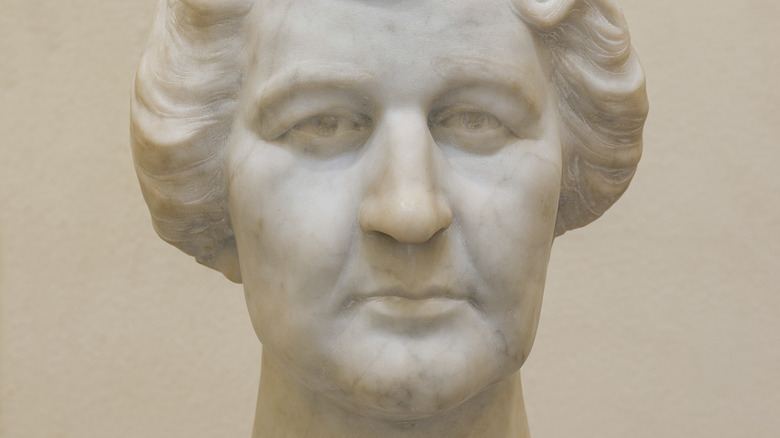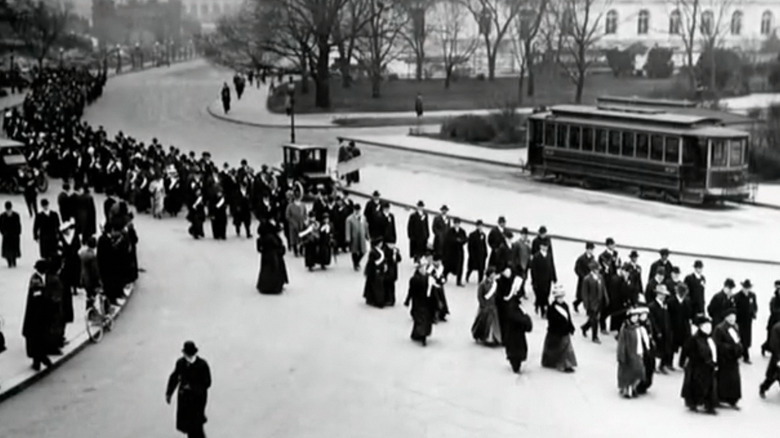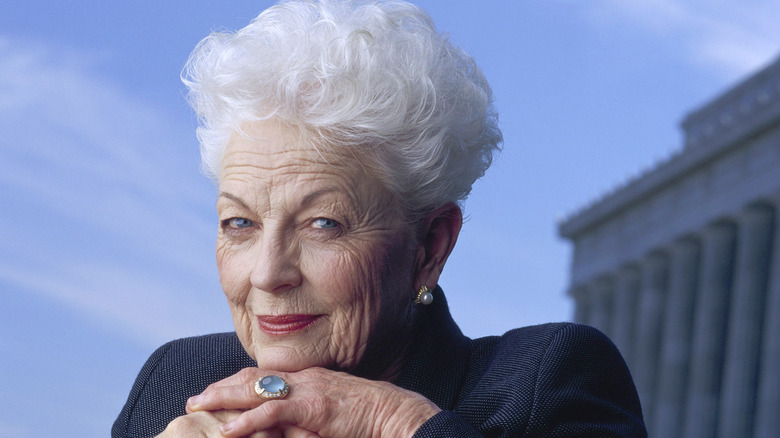The True Story Of The First Woman Governor Of Texas
Texas: It's the land of longhorn cattle, Americanized Mexican food, and sweet, smoky barbecue. One of the most unique U.S. states, Texas has a reputation for both its size and its individualism. With more than a quarter million square miles of land, Texas is bigger than 153 of the world's countries, according to Texas Proud. In other words, it's big enough to be its own nation — and in fact, Texas has seriously considered secession multiple times. It was even its own republic between 1836 and 1845, according to the Texas Tribune.
For now, though, Texas remains a part of the United States, which means the closest thing it has to its own president is its governor. Since 1945, one person has continuously served in Texas' highest political office. Early on, this post was always filled by men. But in 1924, that all changed when Miriam Ferguson was elected to the governor's office, making her only the second woman in the United States to hold such a role.
Who is Miriam Ferguson?
Born in 1875 in Bell County, Texas, Miriam Ferguson was, for most of her life, best known for her association with her husband (via Texas Politics). James Edward Ferguson, who Miriam married in 1899, was the governor of Texas from 1915 to 1917. Prior to becoming governor, James had something of a mixed career trajectory, according to Texas Politics. He actually spent a few years traveling around the country before he eventually decided to pursue a career in law. Then he pivoted to trying his hand at banking while still keeping up his law practice.
It was through the connections he made in these fields that he eventually became interested in politics. A staunch anti-Prohibitionist, Ferguson managed to win the nomination for governor on the behalf of the anti-Prohibitionists in 1914, according to Texas Politics. Shortly after, he was elected to the office of governor, where he served — with Miriam Ferguson as his first lady — for two years in the 1910s.
How she got into politics
Miriam Ferguson herself didn't necessarily have a huge desire to hold a political office, according to Humanities Texas. She went to Baylor Female College, but she dedicated her life to her family instead of her own career endeavors (via Texas Politics). But she was thrust into the role after a scandal that enveloped her husband.
In 1916, James Edward Ferguson was running for reelection when some questions were raised about potential misdeeds, according to Texas Politics. At first, the Texas Congress decided that there was no merit to the concerns, but after James was reelected, more doubts surfaced. When these new allegations were investigated — in addition to a more in-depth investigation into the prior concerns — it was discovered there was enough evidence to convict James. In the end, though he hotly contested the charges, he was impeached by the Texas Congress for crimes including misapplication of public funds and embezzlement.
His punishment? He was removed from his position, and it was ruled that he could never again hold a public office in Texas.
Miriam Ferguson's time as governor
You might think it sounds like James Ferguson got off easy, but he was not satisfied with this ruling, per Texas Politics. He tried to appeal the decision and ran for various other offices as he awaited the decision, including the Senate and the United States presidency. He lost all of those elections. Then, in 1924, the Texas Supreme Court ruled that his ban from public office would stand, meaning James definitely could not ever be governor again (via Britannica).
So what did James do? He got his wife involved. After all, even though he couldn't hold office, the ruling said nothing about what she could do. Miriam ran for the Texas governorship in 1924 while explicitly telling people that electing her would be like electing her husband: that she would, essentially, do anything he asked her to do (via Texas Politics). As she advertised it (via Humanities Texas), Texas voters would get "two governors for the price of one."
People loved it, and in 1924, Miriam was elected to the position, becoming the first female governor of Texas — all as a smokescreen so her husband could take control.
Her policies
In total, Miriam Ferguson served two terms as Texas governor, though they were separated by a break of several years, according to Texas Politics. Among her strongest political stances were her anti-Prohibition stance, her pledge to reduce government spending, and her anti-KKK attitude. Unfortunately, she was not successful in reducing government spending, which likely contributed to her failure to get reelected at the end of her term.
But Miriam, like her husband, wasn't deterred by a single failure. She ran again for office in 1930, and, when that failed, in 1932, when disappointment with the current political situation — largely caused by the Great Depression — got her reelected. Her second term was more successful, though she decided not to run for reelection when it ran out in 1934. In 1940, she gave politics one last hurrah when she made a final run, though she lost the election once more, according to Britannica. Shortly after, her husband died, and she retired, dying herself in 1961.
Other female governors in the United States
Though Miriam Ferguson was the first female governor of Texas, she wasn't the first female governor in the United States. Just two weeks before Miriam took office, a woman named Nellie Tayloe Ross became the governor of Wyoming, according to Texas Politics. Ross' political run was also related to her husband: He had been the governor of Wyoming when he died, and she was elected to finish the rest of his incomplete term, according to the National Governors Association.
After Ross and Ferguson, there weren't any more female governors in the United States until 1967, when a woman named Lurleen Wallace was elected in Alabama, according to Rutgers University. Over the years, there have been a total of 45 female governors in the U.S., including the first female Republican governor, Vesta Roy, who was elected in New Hampshire in 1982. The second female Texas governor was Ann Richards in the 1990s, according to Humanities Texas. There has never been a Black female governor of any U.S. state, according to Insider.





